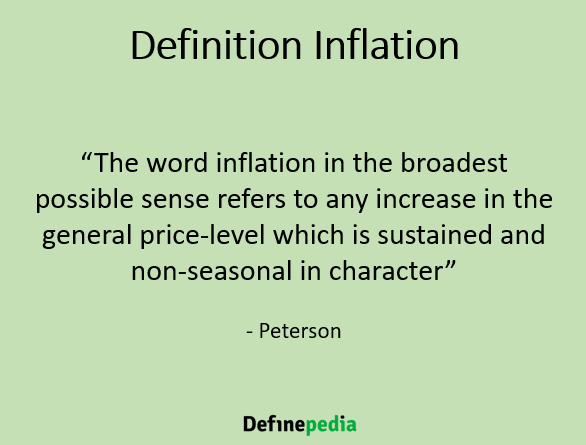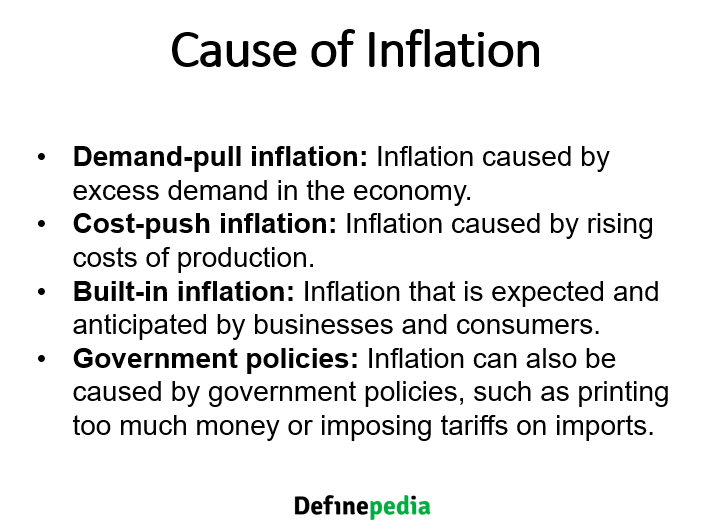Introduction to Inflation
Before I start , let’s imagine that you have a pocket full of money, but suddenly, the prices of everything you love to buy start going up. That’s inflation for you – it’s like the silent ninja of the economic world that can impact your purchasing power.
Definition of Inflation

According to Peterson, “The word inflation in the broadest possible sense refers to any increase in the general price-level which is sustained and non-seasonal in character”.
According to Crowther, “Inflation is a state in which the value of money is falling ,i.e. prices are rising.”
According to Keynes, “The rise in the price-level after the point of full employment is true inflation.”
According to Parkin and Bade, “Inflation is an upward movement in the average level of prices. Its opposite is deflation, a downward movement in the average level of prices. The boundary between inflation and deflation is price stability.”
Types of Inflation
Alright, let’s start by talking about the different flavours of inflation. Inflation isn’t just a one-size-fits-all phenomenon. We’ve got creeping inflation, which is like a slow and steady rise in prices.
Then there’s galloping inflation – think of it as prices running like wild horses! Hyperinflation takes it up a notch, where prices skyrocket almost every day. Lastly, we have stagflation, which is the trickiest of them all – it’s when inflation and unemployment dance together, creating an economic puzzle.
Creeping inflation
This is a slow and steady rise in prices. It is usually below 3% per year. Creeping inflation can be caused by a number of factors, such as increased demand for goods and services, rising production costs, or government policies that increase the money supply.
Creeping inflation can be difficult to detect, but it can have a significant impact on the economy over time. It can erode the purchasing power of wages and savings, and it can make it more difficult for businesses to plan for the future.
Galloping inflation
This is a more rapid rise in prices. It is usually between 3% and 10% per year. Galloping inflation can be caused by the same factors that cause creeping inflation, but it is more severe.
Galloping inflation can be even more destructive than creeping inflation. It can lead to shortages of goods and services, as businesses are unable to keep up with rising prices. It can also lead to social unrest, as people struggle to make ends meet.
Hyperinflation
This is an extremely rapid rise in prices. It is usually over 10% per year. Hyperinflation can be caused by a number of factors, such as a collapse in the currency, a civil war, or a natural disaster.
Hyperinflation is a very rare event, but it can be devastating to an economy. It can wipe out savings, bankrupt businesses, and lead to political instability.
Stagflation
This is a combination of high inflation and high unemployment. It is a very difficult economic condition to manage. Stagflation can be caused by a number of factors, such as a recession, a supply shock, or a government policy that increases the money supply too quickly.
Stagflation is the most difficult type of inflation to manage. It is a lose-lose situation for both businesses and consumers. Businesses are unable to raise prices to cover their costs, and consumers are unable to afford to buy the goods and services they need.
Another point to keep in mind
- Cost-push inflation is caused by an increase in the cost of production. This can happen when wages increase, or when the price of raw materials or energy rises. When the cost of production goes up, businesses pass on the cost to consumers by raising prices.
- Demand-pull inflation is caused by an increase in demand for goods and services. This can happen when the economy is growing rapidly, or when there is a sudden increase in demand for a particular product or service. When demand exceeds supply, businesses can raise prices to try to meet the demand.
Features of Inflation
The main characteristics of inflation are outlined as follows:
- Rise in Price: Inflation involves a real increase in the price level, causing the prices of products to become higher.
- Monetary Phenomenon: Excessive supply of money in the economy is the primary cause of inflations, making it a monetary phenomenon.
- Dynamic Process: Inflation is a dynamic and long-term process that leads to a decline in the value of money over time.
- Demand and Supply: Inflation can arise when demand is high and supply is limited, thus indicating that demand and supply factors contribute to it.
- Decrease in Value: Inflation leads to a decrease in the purchasing power of money, necessitating higher spending to buy products and services.
- Uncertainty: Inflation generates economic uncertainty and reduces investment activity.
- Controllable: Various measures can be taken to control inflation, including managing the money supply, reducing expenditures, and increasing interest rates.
Causes of Inflation

Basically, One major cause is demand-pull inflation. Imagine everyone wants the newest gadget, but there aren’t enough gadgets to go around. As demand increases, so all the gadgets prices also increase.
Then we have cost-push inflation. This one’s like a chain reaction – when production costs increase, businesses pass on the burden to consumers through higher prices. External factors like supply disruptions or rising raw material prices can also light the inflation fire.
- Demand-pull inflation: Inflation caused by excess demand in the economy. This can happen when the economy is growing rapidly, or when there is a sudden increase in demand for a particular product or service.
- Cost-push inflation: Inflation caused by rising costs of production. This can happen when wages increase, or when the price of raw materials or energy rises.
- Built-in inflation: Inflation that is expected and anticipated by businesses and consumers. This can create a self-fulfilling prophecy, as businesses raise prices in response to the higher demand, which then leads to even higher wages and prices.
- Imported inflation: Inflation caused by rising prices of imported goods and services. This can happen when the currency of the importing country depreciates, or when the prices of goods and services in the exporting country rise.
- Government policies: Inflation can also be caused by government policies, such as printing too much money or imposing tariffs on imports.
Effects of Inflation
Inflation isn’t just about numbers – it can impact your daily life too. When prices rise, your money’s purchasing power takes a hit. What used to cost a few dollars might now cost more. Your savings might not stretch as far, and you might even need a raise just to keep up with the rising costs.
Moreover, lenders and borrowers play a seesaw game during inflation. Borrowers might smile as they pay back loans with less valuable money, but lenders might cringe as the real value of what they’re repaid decreases.
Measuring Inflation
Alright, we’ve got a handle on what inflation is and how it affects us. But how do we actually measure it? That’s where inflation indices and baskets of goods come into play.
Economists keep an eye on the prices of various items, from apples to zippers, and calculate the Consumer Price Index (CPI) or Producer Price Index (PPI).
These indices give us a snapshot of how prices are changing over time. And you know what? You can even find fancy charts and calculators online to visualize and calculate inflation rates!